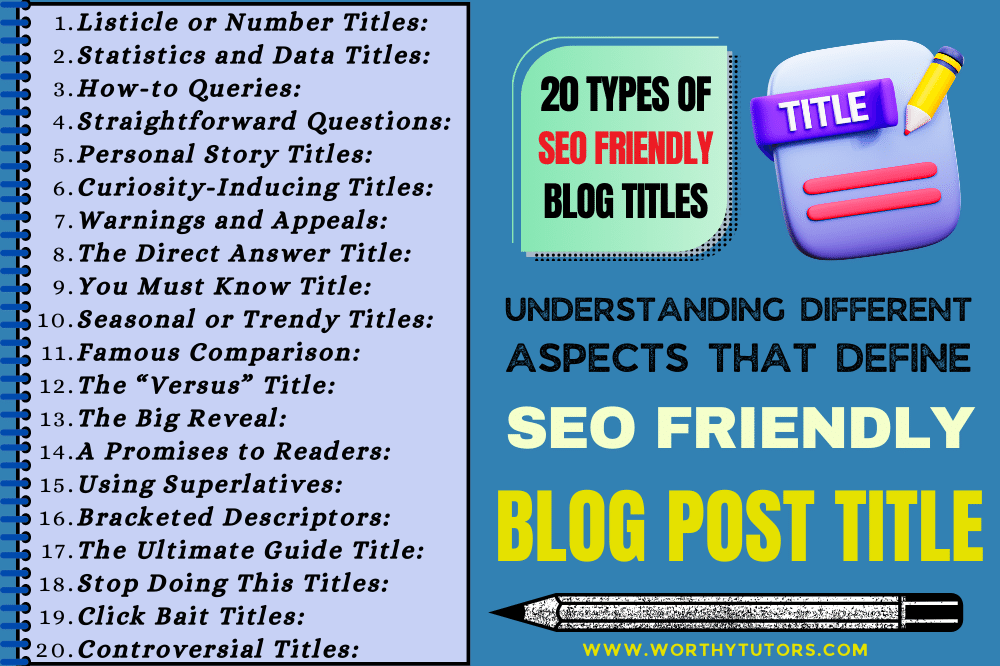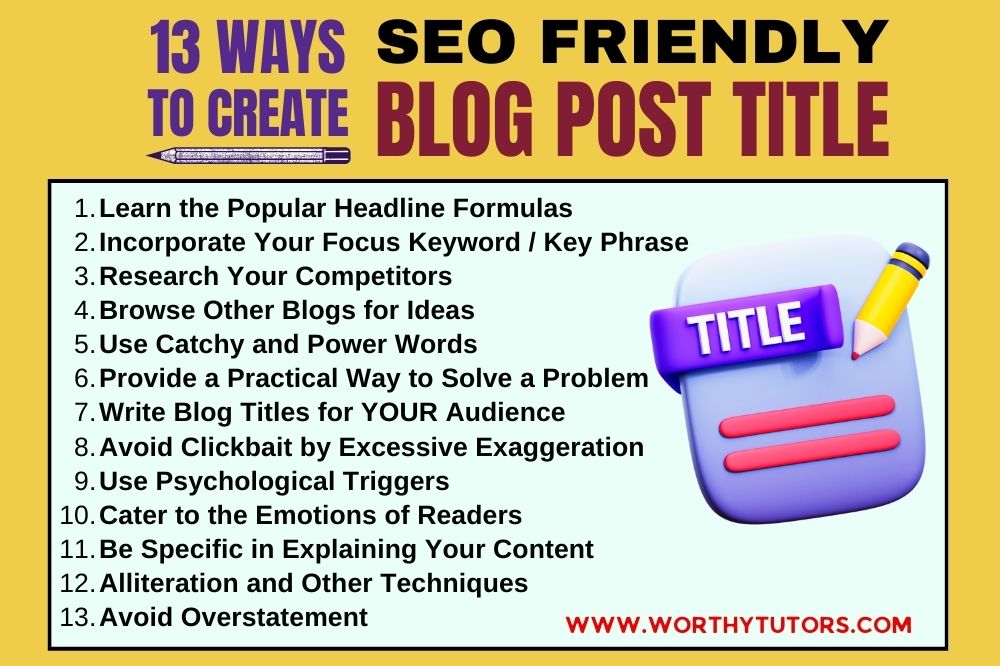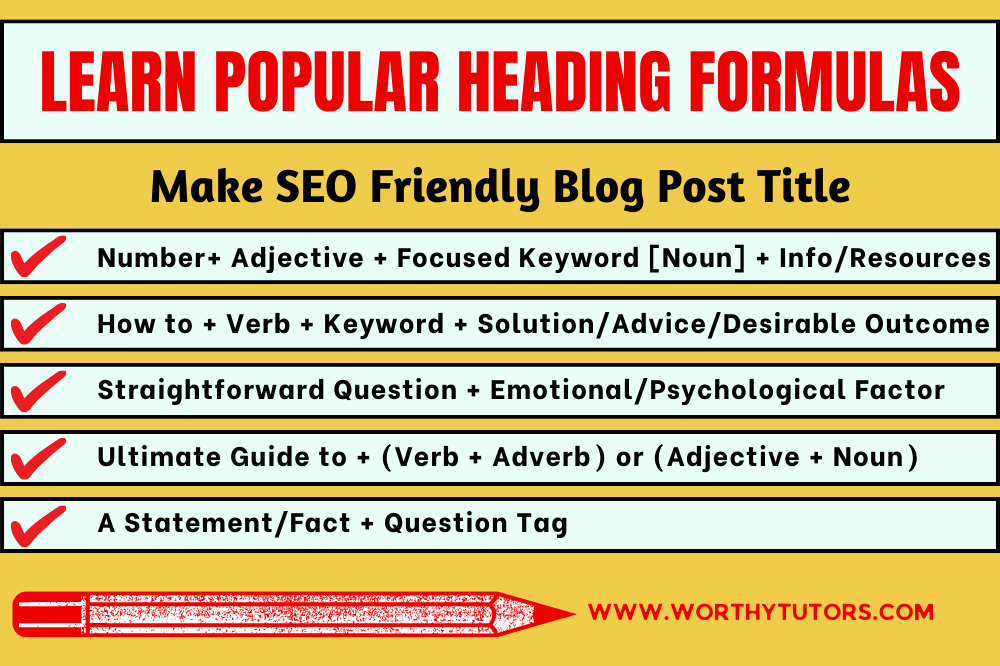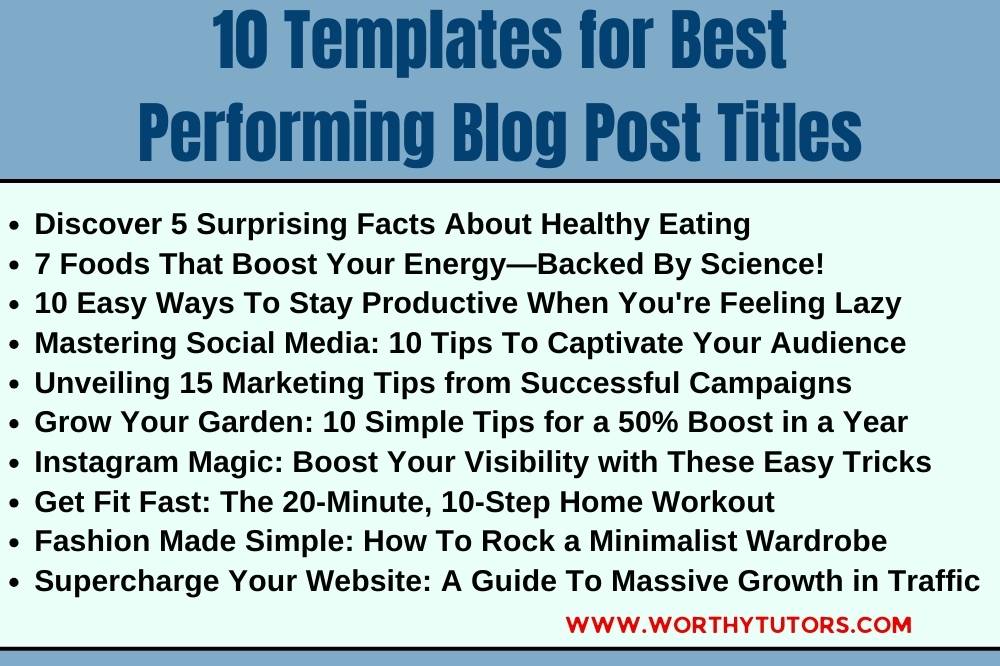
Crafting an effective SEO friendly blog post title is crucial for making a positive first impression on readers. The post title not only influences click-through rates (CTR) but also plays a key role in search engine optimization (SEO). A wisely crafted title with strategic elements can enhance your post’s search engine ranking. The significance of a blog post or page title is comparable to the content itself. In this article, we’ll explore how to create an appealing title with a focused key phrase, highlighting its importance in attracting readers and optimizing for SEO. Avoiding common errors in title creation is essential for leaving a positive impression and preventing readers from bouncing back without engaging with your content.
Importance of a Blog Post Title
The importance of a blog post title cannot be overstated as it holds the power to shape a reader’s initial impression of your article. Serving as the first point of contact on platforms like Google and social media, the title plays a pivotal role in enticing or dissuading readers from clicking into your site. Clicks are the gateway to readership, and without them, your posts remain unread. Furthermore, a well-crafted blog title not only attracts clicks but also stimulates social media shares and contributes to improved rankings in search engine result pages (SERPs). It is imperative to invest thoughtful consideration in creating an impactful blog title, aligning it with your target keyword, core audience, and overall message. The title is not just a mere introduction; it is the key element that determines whether readers click through to explore the entirety of your blog post. Success in the digital realm hinges on the ability to generate a compelling blog title, a crucial factor in garnering social media shares and reader engagement.
Understanding Different Aspects that Define an SEO-Friendly Blog Post Title

Listicle or Number Titles:
Listicle titles organize information into a numbered or bulleted list, making it easy and clear for readers to understand. They tell a specific number of items or tips explained in the post/article.
Example: “10 Catchy Blog Post Title Ideas to Spark Your Creativity”
Statistics and Data Titles:
Titles incorporating statistics or data appeal to those seeking some factual information, positioning the content as evidence-based and informative.
Example: “The Impact of Captivating Blog Post Titles: Statistics Unveiled”
How-to Queries:
How-to titles promise practical guidance, addressing a specific query or concern that readers may have.
Example: “How to Make an Attractive SEO Friendly Blog Post Title”
Questions:
Question titles directly address the reader, prompting engagement by posing a question that the content will answer.
Example: “Why Are Blog Post Titles So Important in SEO?”
Personal Story Titles:
Personal story titles add authenticity and relatability to the content, often sharing the author’s experiences or journey.
Example: “My Journey to Crafting Irresistible Blog Post Titles”
Curiosity-Inducing Titles:
Curiosity-inducing titles create intrigue by hinting at unexpected or unknown information, enticing readers to click and discover more.
Example: “The Surprising Secrets Behind Creating Strategic Blog Post Titles”
Warnings and Appeals:
Titles with warnings or appeals highlight potential consequences, urging readers to take action or heed advice for better outcomes.
Example: “The Consequences of Ignoring Your Blog Post Titles’ Impact on SEO”
The Direct Answer Title:
Direct answer titles provide a straightforward response to a question or concern, offering clarity and immediate value.
Example: “Yes! Blog Post Titles Can Make or Break Your SEO: Here’s Why”
You Must Know:
“You Must Know” titles emphasize essential information, suggesting that the content holds crucial insights or advice.
Example: “What You Must Know About Crafting Effective Blog Post Titles”
Seasonal or Trendy Titles:
Seasonal or trendy titles align with current events, holidays, or popular trends, making the content timely and relevant.
Example: “Tips for Creating Blog Post on COVID-19”
Famous Comparison:
Famous comparison titles draw parallels between well-known entities, creating a compelling narrative for readers.
Example: “Know the Differences Between Title of the Post and Content Headings”
The “Versus” Title:
The “Versus” title sets up a comparison or competition, prompting readers to explore the contrasts between two elements.
Example: “H1 of the Post vs. Meta Descriptions: Which one is more important for SEO”
The Big Reveal:
Titles with the “Big Reveal” promise significant revelations or insights, building anticipation and curiosity.
Example: “The Big Reveal: Unveiling the Art of Magnetic Blog Post Titles”
A Promises to Readers:
Titles making promises to readers assure a specific benefit or outcome, encouraging them to click for valuable content.
Example: “Blog Post Titles Ideas That Increases CTR Even Without SEO”
Using Superlatives:
Titles with superlatives emphasize extremes, suggesting that the content is the best, most comprehensive, or highly impactful.
Example: “Mastering the Art: Crafting the Most Engaging Blog Post Titles Ever”
Bracketed Descriptors:
Bracketed descriptor titles use brackets to highlight specific details or elements, adding clarity and focus to the title.
Example: “Enhance Your Clicks: [Secrets] to Crafting Powerful Blog Post Titles”
The Ultimate Guide Title:
The “Ultimate Guide” title positions the content as a comprehensive resource, promising in-depth information on the topic.
Example: “The Ultimate Guide to Mastering SEO-Friendly Blog Post Titles”
Stop Doing This Titles:
“Stop Doing This” titles address common mistakes or pitfalls, offering valuable advice and insights to readers.
Example: “Stop Doing Common Mistakes in Crafting Blog Post Titles”
Click Bait Titles:
Click bait titles use enticing language to grab attention and generate curiosity, prompting readers to click and explore further.
Example: “The Magic Behind Flamboyant Blog Post Titles to Increase Traffic”
Controversial Titles:
Controversial titles challenge common beliefs or ideas, generating curiosity and encouraging readers to engage with the content.
Example: “Debunking Common Myths: Why Traditional Blog Post Titles Are Overrated”.
Different Ways to Make SEO Friendly Blog Post Titles

There are many way to create blog post titles depending on users’ need and type of content. Here we will discuss most trending ways that perform well on SERP pages.
Learn the Popular Headline Formulas:
Crafting SEO-friendly blog post titles becomes more accessible with popular headline formulas. One effective template involves using numbers, adjectives, focused keywords, and additional information/resources. For instance, the “Number + Adjective + Focused Keyword [Noun] + Additional Information/Resources” template provides a structured approach. Consider this example: “5 Exciting Blog Post Title Ideas for Improved SEO Performance.” This structure not only organizes your content but also attracts readers looking for specific information.

Here are few of the most trending blog title formula template that people use to rank their content on SEPSs.
- Number+ Adjective + Focused Keyword [Noun] + Additional Information/Resources
- How to + Verb + Focused Keyword [Noun] + Solution/Advice/Desirable Outcome
- Straightforward Question + Emotional/Psychological Factor
- Ultimate Guide to + (Verb + Adverb) or (Adjective + Noun)
- A Statement/Fact + Question Tag
Incorporate Your Focus Keyword / Key Phrase:
Beyond impressing readers, it’s crucial to make your blog titles SEO-friendly by including the focus keyword in the H1. This practice helps search engines understand the purpose of your blog. For example, if your focus is on blog post titles, a well-optimized title could be “Mastering SEO: Crafting Irresistible Blog Post Titles.” Consistency between your H1 and title tag enhances both SEO and user experience.
Research Your Competitors:
Understanding your competitors’ content is essential. Analyze titles resonating with shared audiences, and use tools like Semrush or Ahrefs to identify SEO competitors. For instance, in a fashion blog, you might find inspiration from competitors with titles like “Trendy Fashion Picks: The Ultimate Guide for Every Season.” By understanding successful approaches, you can refine your own strategies for creating compelling titles.
Browse Other Blogs for Ideas:
Embark on your blogging journey by exploring popular blogs for inspiration. Study attention-grabbing titles and identify words that make them stand out. For instance, a photography blog catering to beginners could use a title like “Demystifying HDR Photography: A Beginner’s Guide.” By incorporating beginner-friendly language, your title becomes more appealing and less intimidating.
Use Catchy and Power Words:
Power words are instrumental in making your blog post titles stand out. Examples like “Secret,” “Bizarre,” or “Unexplained” can add intrigue. Consider a title like “Unlocking the Secrets: Crafting Powerful Blog Post Titles.” These power words create curiosity and entice readers to explore your content further.
Provide a Practical Way to Solve a Problem:
Titles that focus on practical value offer solutions to readers. By including your value proposition directly in the title, you set clear expectations. For example, a title like “The 10-Minute, 10-Step Solution for Crafting Captivating Blog Post Titles” promises a quick and actionable guide, providing immediate value to your audience.
Write Blog Titles for YOUR Audience:
Tailoring your titles to your target audience is essential for engagement. For instance, if you have a photography blog for beginners, simplify jargon and use titles like “What is Dynamic Range in Photography?” to make content less intimidating. By understanding your audience’s language and preferences, you can create titles that resonate and capture their attention.
Avoid Clickbait by Excessive Exaggeration:
Crafting honest titles that set proper expectations is crucial. Distinguish between click-worthy titles and clickbait, ensuring your titles promise real value to the audience. For instance, instead of exaggerated claims, create titles like “Crafting Honest and Effective Blog Post Titles” to maintain credibility and build trust with your readers.
Use Psychological Triggers:
Incorporate psychological triggers like curiosity, amazement, or uncertainty to influence social shares. For example, a title like “Unveiling the Mystery: The Psychology Behind Click-Worthy Blog Titles” taps into readers’ curiosity, encouraging them to explore your content further.
Cater to the Emotions of Readers:
Appealing to emotions by using modifiers like “heartwarming” or “best” in titles creates a more engaging experience for readers. For instance, tailor titles like “5 of the Best Horror Video Games to Play in the Dark” to evoke specific emotions. Understanding your audience’s emotional responses allows you to craft titles that resonate on a deeper level.
Be Specific in Explaining Your Content:
Crafting specific titles that clearly communicate what readers can expect is crucial in a world with short attention spans. For example, a title like “10 Tips for Captivating Blog Titles: A Practical Guide” not only informs readers about the content but also sets the tone for the level of detail and seriousness they can expect. Clarity in your titles helps manage expectations and ensures your content aligns with what your audience is seeking.
Experiment with Alliteration and Other Techniques:
Explore creative techniques like alliteration for catchy titles. For instance, “13 Silly Superstitions Still in Circulation Today” adds zest to the content. Clever headlines, especially those with alliteration or witty jokes, can be more effective at capturing a reader’s attention, especially when promoting your blog on social media.
Avoid Overstatement:
Maintain credibility by ensuring your blog title aligns with the content of the post. For instance, use titles like “Crafting Effective Blog Post Titles: A Practical Guide” instead of making exaggerated claims that might not be fulfilled. Honesty in your titles builds trust with your audience and ensures a positive reader experience.
What should be the length of an SEO Friendly Blog post Title?
While there is no strict character limit enforced by Google or Ahrefs for blog post titles, it’s generally recommended to keep your titles concise and within a range that ensures they display well in search engine results pages (SERPs) and don’t get cut off. Google typically displays the first 50-60 characters of a title tag on its search results pages. However, this can vary, and Google may sometimes show longer titles if it deems them relevant. Keep in mind that your blog post title should be easily readable and understandable to users. Avoid excessively long titles that may overwhelm or confuse your audience. Place important keywords near the beginning of the title to ensure they are visible and capture attention quickly. This can also contribute to better search engine optimization (SEO). While Ahrefs doesn’t enforce a specific character limit, their research suggests that titles with 60 characters or less tend to perform well in terms of click-through rates (CTR).
Best Websites and Tools to Get SEO Friendly Blog Titles/ Articles’ H1 Tag
Several websites and tools can assist young content writers in creating SEO-friendly blog post titles. Here are some valuable resources:
CoSchedule Headline Analyzer:
Description: CoSchedule offers a free Headline Analyzer tool that evaluates the overall quality and SEO-friendliness of your blog post titles. It provides insights on word balance, length, and the inclusion of powerful and emotional words.
HubSpot’s Blog Ideas Generator:
Description: HubSpot’s tool helps generate creative blog title ideas based on three relevant nouns you input. While it doesn’t specifically focus on SEO, it can spark inspiration and be a starting point for crafting titles.
Portent’s Content Idea Generator
Description: Portent’s tool generates catchy and creative blog post titles. While it may provide humorous suggestions, it prompts users to think outside the box, potentially leading to unique SEO-friendly titles.
Ahrefs SEO Toolbar:
Description: Ahrefs’ SEO Toolbar is a browser extension that displays valuable SEO metrics while you browse the web. It can help content writers analyze competitors’ titles and understand keyword trends.
TweakYourBiz Title Generator:
Description: TweakYourBiz offers a title generator that suggests blog post titles based on the topic or keyword you input. It provides various title suggestions, helping writers explore different angles for their content.
Google Trends:
Description: Google Trends allows content writers to explore trending topics and keywords. By identifying popular search queries related to their niche, writers can craft titles that align with current interests.
Yoast SEO:
Description: Yoast SEO is a popular WordPress plugin that provides real-time SEO analysis for blog posts. It helps writers optimize titles for search engines by offering suggestions to improve readability and keyword usage.
BuzzSumo:
Description: BuzzSumo helps content creators identify trending topics and popular content in their niche. By understanding what performs well, writers can tailor their titles for better engagement.
Remember, while these tools can be helpful, it’s essential for content writers to also develop an understanding of SEO principles and audience preferences. Combining these tools with knowledge of your target audience and regular performance analysis can contribute to creating effective and SEO-friendly blog post titles.
10 Sample Templates for Best Performing Blog Post Titles

- Discover 5 Surprising Facts About Healthy Eating
- 7 Foods That Boost Your Energy—Backed By Science!
- 10 Easy Ways To Stay Productive When You’re Feeling Lazy
- Mastering Social Media: 10 Tips To Captivate Your Audience
- Unveiling 15 Marketing Tips from Successful Campaigns
- Grow Your Garden: 10 Simple Tips for a 50% Boost in a Year
- Instagram Magic: Boost Your Visibility with These Easy Tricks
- Get Fit Fast: The 20-Minute, 10-Step Home Workout
- Fashion Made Simple: How To Rock a Minimalist Wardrobe
- Supercharge Your Website: A Guide To Massive Growth in Traffic
Learn Content Writing, Blogging, & SEO
Introduction to Blogging
How to Start Blogging
Scope of Content Writing
Different Forms of Content Writing
Types of SEO
Keyword Research Strategies
Blogging & Content Writing Terms
How to Make Title of a Blog Post?
How to Improve Readability Score?
Heading Structure of a Blog Post